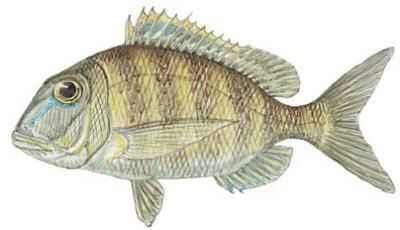Jolthead Porgy

Species Details
Calamus Bajonado
Sparidae
Perciformes
offshore, nearshore, reefs
13 - 18 lbs.
14" - 20"
Jolthead Porgy (Calamus bajonado) Fish Description
The Jolthead Porgy (Calamus bajonado), or Bojanado as it’s sometimes called in the US, is a popular gamefish mostly found in the western Atlantic Ocean. It is mainly targeted by recreational anglers for its tasty meat and, despite its small stature, the challenge of catching this rather feisty fish. The name derives from its feeding habit of “jolting” mollusks from rocks.
The Jolthead Porgy can easily be recognized by its rather unique appearance. It has a roundish head, a pointed snout, and a small mouth. Like all porgies, it has big round eyes, and its body is compressed laterally, although its back is a lot more arched as compared to its cousins’. Its color is also duller than its colorful relatives as it is mostly brassy silver in color with a bluish to brownish tint on top. Other distinguishing features include: a brown forehead, a blue line below each eye, a long and spiny dorsal fin, and the corner of its mouth is orange.
Little is known about its spawning behavior save that it usually spawns during the summer months and it migrates to deeper parts of the ocean to spawn.
Diet and Size
Jolthead Porgy average sizes tend to be between fourteen to twenty inches. Although the world record catch measured more than twenty-four inches, individuals reaching more than twenty inches are quite rare. This fish is also known to be quite a loner and tend to swim on its own at a very slow pace. However, it can still swim fast although in bursts and short distances.
The Jolthead Porgy is a carnivore that feeds mainly on crustaceans, soft-shelled mollusks, and occasionally some small fishes.
Jolthead Porgy Interesting Facts
- The biggest Jolthead Porgy ever caught ion record measures two and a half feet and weighs a little more than twenty-three pounds.
- The world record fish was caught off Madeira Beach, Florida in 1990.
- “Bojonado” came from the Spanish words bojo and nado, which means “low swimming.”
- The English name derives from its feeding habit of “jolting” or snatching mollusks from rocks.
- It is the dullest colored member of the Sparidae family of fish.
- It is mostly solitary although it can sometimes be seen swimming in schools.
- As a bottom-dweller, this fish mostly preys on crabs, mollusks, and sea urchins.
- Because they are kind of shaped similarly, the Jolthead Porgy is often confused with its close relatives the Knobbed Porgy and Littlehead Porgy.
- Their population is stable and widely distributed across the waters of the Western Atlantic Ocean.
- Although it mostly prefers reefs and grass beds, it can adapt well to a wide range of habitats.
- Jolthead Porgy meat is said to be firm and has a delicate sweet taste that can be cooked in several ways including grilled, steamed, fried, or baked.
- There are some cases of Ciguatera toxin poisoning from eating this fish.
- They can be caught in a number of methods including trawls, longlines, as well as by hook and line.
Fishing Tips
Jolthead Porgies can be caught onshore or nearshore using a light spinning and baitcasting tackle. It’s known to be a voracious predator and can easily be drawn in using various baits including shrimp, crab, mussels, clams, or strip fish—dead or alive. And although they may be relatively small, it’s known to be quite a strong fighter and may even try to snap the line by swimming through rocks. So once you hook the fish, expect a fairly long battle.
Jolthead Porgy Habitat and Distribution
The Jolthead Porgy dwells and feeds at the bottom-most of the time. It usually prefers to stay over grass beds and around offshore reefs and patches. But it can still wander to different habitats, especially when hunting for food. It’s mostly common within waters of twenty to thirty feet in depth, but sometimes can be found hunting deeper in as much as one hundred and fifty feet.
This fish can be found along the coasts of the western Atlantic Ocean—from Rhode Island to Brazil. It is also abundant within the Gulf of Mexico and the Caribbean Sea as well as near the islands of the West Indies.







